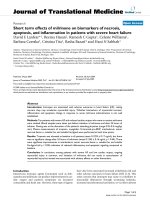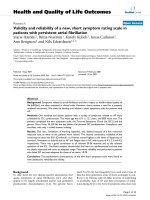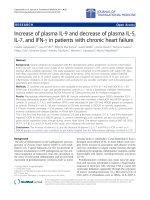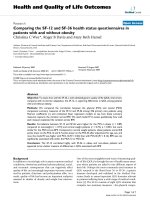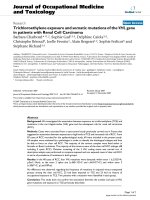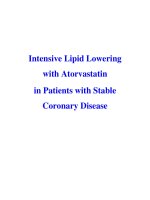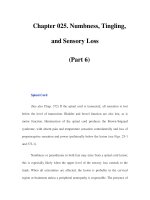Chapter 082. Infections in Patients with Cancer (Part 6) pot
Bạn đang xem bản rút gọn của tài liệu. Xem và tải ngay bản đầy đủ của tài liệu tại đây (48.1 KB, 5 trang )
Chapter 082. Infections in
Patients with Cancer
(Part 6)
More common than tunnel infections are exit-site infections, often with
erythema around the area where the line penetrates the skin. Most authorities
(Chap. 129) recommend treatment (usually with vancomycin) for an exit-site
infection caused by a coagulase-negative Staphylococcus. Treatment of coagulase-
positive staphylococcal infection is associated with a poorer outcome, and it is
advisable to remove the catheter if possible. Similarly, many clinicians remove
catheters associated with infections due to P. aeruginosa and Candida species,
since such infections are difficult to treat and bloodstream infections with these
organisms are likely to be deadly. Catheter infections caused by Burkholderia
cepacia, Stenotrophomonas spp., Agrobacterium spp., and Acinetobacter
baumannii as well as Pseudomonas spp. other than aeruginosa are likely to be
very difficult to eradicate with antibiotics alone. Similarly, isolation of Bacillus,
Corynebacterium, and Mycobacterium spp. should prompt removal of the catheter.
Gastrointestinal Tract–Specific Syndromes
Upper Gastrointestinal Tract Disease
Infections of the Mouth
The oral cavity is rich in aerobic and anaerobic bacteria (Chap. 157) that
normally live in a commensal relationship with the host. The antimetabolic effects
of chemotherapy cause a breakdown of host defenses, leading to ulceration of the
mouth and the potential for invasion by resident bacteria. Mouth ulcerations afflict
most patients receiving chemotherapy and have been associated with viridans
streptococcal bacteremia. The use of keratinocyte growth factor (palifermin) in a
daily dose of 60 µg/kg for 3 days before chemotherapy and total-body irradiation
is of proven value in preventing mucosal ulceration after stem cell transplantation.
Fluconazole is clearly effective in the treatment of both local infections (thrush)
and systemic infections (esophagitis) due to Candida albicans. Newer azoles (such
as voriconazole) are similarly effective.
Noma (cancrum oris), commonly seen in malnourished children, is a
penetrating disease of the soft and hard tissues of the mouth and adjacent sites,
with resulting necrosis and gangrene. It has a counterpart in immunocompromised
patients and is thought to be due to invasion of the tissues by Bacteroides,
Fusobacterium, and other normal inhabitants of the mouth. Noma is associated
with debility, poor oral hygiene, and immunosuppression.
Viruses, particularly HSV, are a prominent cause of morbidity in
immunocompromised patients, in whom they are associated with severe mucositis.
The use of acyclovir, either prophylactically or therapeutically, is of value.
Esophageal Infections
The differential diagnosis of esophagitis (usually presenting as substernal
chest pain upon swallowing) includes herpes simplex and candidiasis, both of
which are readily treatable.
Lower Gastrointestinal Tract Disease
Hepatic candidiasis (Chap. 196) results from seeding of the liver (usually
from a gastrointestinal source) in neutropenic patients. It is most common in
patients being treated for acute leukemia and usually presents symptomatically
around the time the neutropenia resolves. The characteristic picture is that of
persistent fever unresponsive to antibiotics; abdominal pain and tenderness or
nausea; and elevated serum levels of alkaline phosphatase in a patient with
hematologic malignancy who has recently recovered from neutropenia. The
diagnosis of this disease (which may present in an indolent manner and persist for
several months) is based on the finding of yeasts or pseudohyphae in
granulomatous lesions.
Hepatic ultrasound or CT may reveal bull's-eye lesions. In some cases, MRI
reveals small lesions not visible by other imaging modalities. The pathology (a
granulomatous response) and the timing (with resolution of neutropenia and an
elevation in granulocyte count) suggest that the host response to Candida is an
important component of the manifestations of disease. In many cases, although
organisms are visible, cultures of biopsied material may be negative.
The designation hepatosplenic candidiasis or hepatic candidiasis is a
misnomer because the disease often involves the kidneys and other tissues; the
term chronic disseminated candidiasis may be more appropriate. Because of the
risk of bleeding with liver biopsy, diagnosis is often based on imaging studies
(MRI, CT). Amphotericin B is traditionally used for therapy (often for several
months, until all manifestations of disease have disappeared), but fluconazole may
be useful for outpatient therapy. The use of other antifungal agents and
combination therapy is less well studied.

